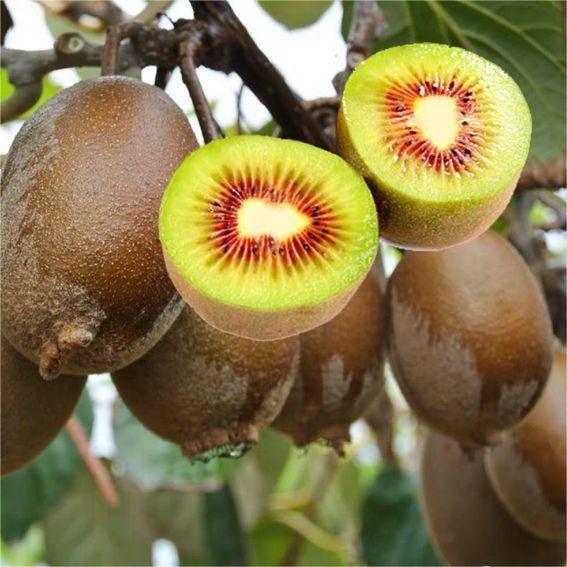저자 소개:
안휘 푸양(ANHUI FUYANG) 글 진펑 원예 전문성과 프리미엄 품질의 식물, 나무가 만나는 에코아그리컬처(주)! 30년 이상의 경험을 바탕으로 당사는 귀하의 모든 원예 요구 사항에 맞는 최고 수준의 식물을 제공하는 전문가로서 명성을 쌓아왔습니다. 몇 개의 보잘것없는 플라스틱 온실로 시작한 것이 약 300에이커에 달하는 거대한 사업장으로 꽃을 피웠습니다.

생기 넘치는 녹색 과육과 달콤하고 시큼한 맛을 지닌 키위는 어떤 과수원에도 기분 좋은 첨가물이 됩니다. 숙련된 정원사이든 초보자이든 키위 재배는 보람 있고 즐거운 경험이 될 수 있습니다. 이에 이해
-
다양한 선택:
키위 재배 여행을 시작하기 전에 기후와 선호도에 맞는 품종을 선택하는 것이 중요합니다. 키위의 두 가지 주요 유형은 퍼지 키위(Actinidia deliciosa)와 부드러운 키위(Actinidia chinensis)입니다. 퍼지 키위가 가장 일반적인 유형인 반면, 부드러운 키위는 더 달콤한 맛과 더 부드러운 질감으로 알려져 있습니다.
-
심기:
키위 덩굴은 유기물이 풍부하고 배수가 잘 되는 토양에서 잘 자랍니다. 봄에 마지막 서리가 내린 후 햇볕이 잘 드는 곳에 심습니다. 토양의 pH는 5.5~7.5 사이여야 합니다. 토양이 너무 산성이면 석회를 첨가하여 pH를 높일 수 있습니다. 포도나무가 튼튼한 격자 시스템에서 자라도록 훈련하고 약 10피트 간격을 둡니다.
-
살수:
키위 덩굴은 특히 성장기 동안 정기적으로 물을 주어야 합니다. 그들은 촉촉한 토양을 선호하지만 고인 물을 용납하지 않습니다. 깊은 뿌리 성장을 촉진하기 위해 깊고 자주 물을 줍니다. 식물 뿌리 주위에 멀칭을 하면 수분을 유지하고 잡초 성장을 억제하는 데 도움이 됩니다.
-
비료:
풍성한 수확을 보장하기 위해, 키위 덩굴 정기적인 비료가 필요합니다. 성장기 동안 4~6주마다 10-10-10 또는 20-20-20과 같은 균형 잡힌 비료를 줍니다. 적용 비율은 제조업체의 지침을 따르십시오. 또한, 심기 전에 퇴비와 같은 유기물을 토양에 혼합하면 장기적인 영양 혜택을 제공할 수 있습니다.
-
전정:
키위나무의 건강과 생산성을 유지하려면 가지치기가 필수적입니다. 겨울 가지치기에는 포도나무가 휴면 상태일 때 죽거나 병든 나무를 제거하고, 과밀한 가지를 엷게 하고, 포도나무 모양을 만드는 작업이 포함됩니다. 여름 가지치기는 과도한 성장을 억제하고 에너지를 과일 생산에 집중하며 포도나무의 크기와 모양을 유지하는 데 중점을 둡니다.

-
수분:
키위 식물은 자웅이성 식물입니다. 즉, 수컷과 암컷 식물이 분리되어 있습니다. 과일 생산을 보장하려면 수분을 위해 수컷 식물과 암컷 식물을 모두 가까이 두는 것이 중요합니다. 일부 키위 품종은 자가수정이 가능하지만, 근처에 수그루가 있으면 과일의 착화율과 수확량이 증가할 수 있습니다.
-
해충 및 질병 관리:
여느 과일 작물과 마찬가지로, 키위 과일 해충과 질병에 취약합니다. 일반적인 해충으로는 진딧물, 진드기, 비늘벌레, 애벌레 등이 있습니다. 정기적인 모니터링, 조기 발견 및 통합 해충 관리(IPM) 실행은 해충을 효과적으로 통제하는 데 도움이 될 수 있습니다. 세균성 구내염, 흰가루병, 뿌리 썩음병과 같은 질병은 적절한 위생, 질병 저항성 품종, 그리고 필요한 경우 살균제의 현명한 사용을 통해 관리할 수 있습니다.
-
수확 및 보관:
키위는 일반적으로 과일이 완전히 익는 가을인 9월에서 11월 사이에 수확됩니다. 과일은 단단해야 하지만 부드러운 압력을 가하면 굴복됩니다. 너무 일찍 따면 열매가 제대로 익지 않을 수 있습니다. 수확 후 키위는 서늘하고 건조한 곳에 몇 주 동안 보관할 수 있습니다. 하지만 가장 신선한 맛과 식감을 위해서는 최대한 빨리 섭취하는 것이 가장 좋습니다.
결론:
키위를 재배하려면 세심한 주의와 적절한 관리가 필요하지만 올바른 기술을 사용하면 맛있는 과일을 풍성하게 수확할 수 있습니다. 올바른 품종 선택부터 최적의 성장 조건 제공, 좋은 가지치기 기술 연습, 해충 및 질병 통제 조치 구현에 이르기까지 성공적인 키위 정원을 향한 길을 잘 걷게 될 것입니다. 특정 기후에 따라 접근 방식을 조정하고 추가 지원을 받으려면 현지 전문가의 지침을 구하세요. 키위가 잘 자라서 행복해요!
